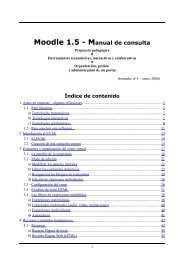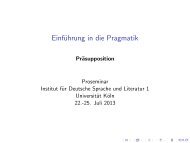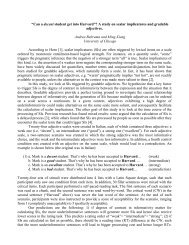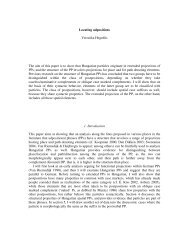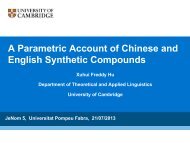Semantic aspects of differential object marking - corpora@parles.upf ...
Semantic aspects of differential object marking - corpora@parles.upf ...
Semantic aspects of differential object marking - corpora@parles.upf ...
You also want an ePaper? Increase the reach of your titles
YUMPU automatically turns print PDFs into web optimized ePapers that Google loves.
<strong>Semantic</strong> <strong>aspects</strong> <strong>of</strong> <strong>differential</strong> <strong>object</strong> <strong>marking</strong> 5<br />
In Hindi direct <strong>object</strong>s can be marked with ko, the same marker that is used for indirect <strong>object</strong>s. 3<br />
In the present discussion we limit ourselves to the use <strong>of</strong> ko on direct <strong>object</strong>s that occur without<br />
a determiner. The <strong>differential</strong> use <strong>of</strong> ko on direct <strong>object</strong>s has received much attention in the literature<br />
(see, e.g., Mohanan 1990, Butt 1993, Singh 1994, McGregor 1995, Aissen 2003, de Hoop<br />
and Narasimhan 2005, Kachru 2006) and two factors can be distinguished that influence it. On<br />
the one hand, there is animacy as ko is obligatory for <strong>object</strong>s that are human but not for <strong>object</strong>s<br />
that are animate or inanimate. On the other hand, the occurrence <strong>of</strong> ko is related to the definiteness<br />
or specificity <strong>of</strong> the direct <strong>object</strong>, but authors differ as to which factor they take to be the<br />
primary factor. Mohanan (1990), for instance, seems to relate DOM in Hindi mainly to definiteness<br />
with specificity playing a secondary role. Butt (1993), on the other hand, takes specificity<br />
to be the relevant notion but acknowledges that it interacts with definiteness. In this paper we<br />
do not make a principled choice for one or the other factor but in our discussion follow the<br />
respective authors the data come from. Whether we call the interpretation given to a ko-marked<br />
direct <strong>object</strong> definite or specific and that <strong>of</strong> an unmarked direct <strong>object</strong> indefinite or non-specific<br />
does not affect our claim that animacy takes priority over definiteness/specificity in the use <strong>of</strong><br />
ko. 4<br />
Following the data in Mohanan (1990), human <strong>object</strong>s have to be obligatorily marked with ko.<br />
When a human <strong>object</strong> is marked with this <strong>object</strong> marker, it can be interpreted as definite or<br />
indefinite. When a human <strong>object</strong> occurs without ko this results in an ungrammatical sentence.<br />
This contrast is shown in (11) and (12) for the noun ‘child’.<br />
HINDI (Indo-Aryan; Mohanan 1990:103)<br />
(11) ilaa-ne bacce-ko uthayaa<br />
Ila-ERG child-KO lift.PERF<br />
‘Ila lifted the/a child.’<br />
(12) *ilaa-ne baccaa uthayaa<br />
Ila-ERG child lift.PERF<br />
In the absence <strong>of</strong> a determiner, inanimate nouns, on the other hand, can either be marked with<br />
ko or be left unmarked. The use <strong>of</strong> ko does have repercussions for the interpretation associated<br />
with the direct <strong>object</strong>. An unmarked inanimate can be interpreted as definite or indefinite, as is<br />
shown in (13).<br />
HINDI (Indo-Aryan; Mohanan 1990:103)<br />
(13) ilaa-ne haar uthaayaa<br />
Ila.ERG necklace lift.PERF<br />
‘Ila lifted a/the necklace.’<br />
Definiteness <strong>of</strong> an inanimate noun is expressed by using ko. This is shown for the noun ‘necklace’<br />
in (14) below.<br />
3 In the interlinear gloss we label the use <strong>of</strong> ko on indirect <strong>object</strong>s as dative (DAT) and the use on direct <strong>object</strong>s as<br />
KO. In this paper we stay agnostic about the theoretical case status <strong>of</strong> ko on direct <strong>object</strong>s. Some authors identify it<br />
with accusative case (e.g., Mohanan 1990) and label the unmarked <strong>object</strong> with nominative case. Others reject this<br />
analysis and label the unmarked <strong>object</strong> nominative in presence <strong>of</strong> a non-nominative subject but accusative in the<br />
presence <strong>of</strong> a nominative subject (e.g., Anand and Nevins 2006, Woolford to appear). The status <strong>of</strong> ko is unclear<br />
under the latter account and is sometimes simply referred to as <strong>object</strong>ive case.<br />
4 The distinction between definiteness and specificity is notoriously difficult (see von Heusinger 2002 for a<br />
discussion).<br />
602<br />
5




